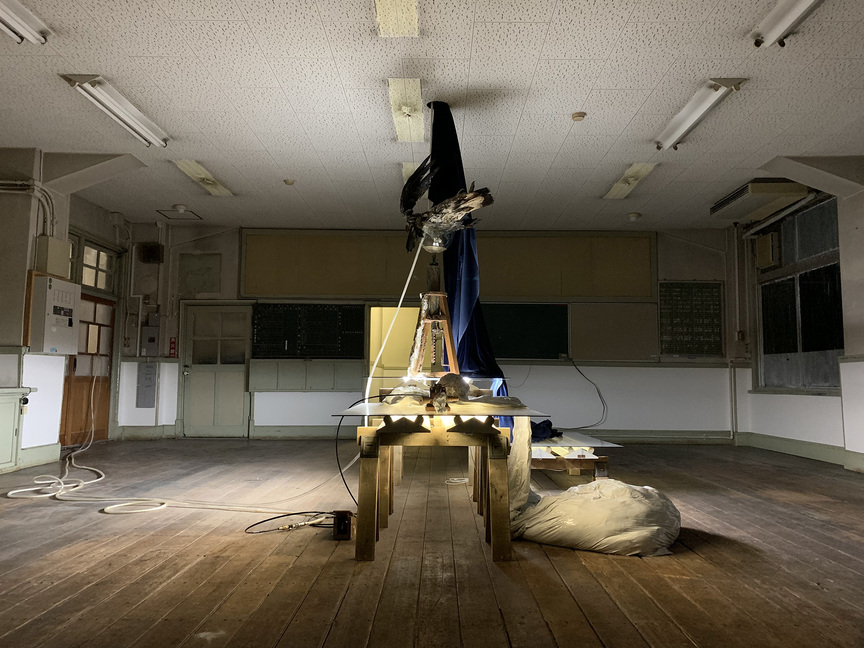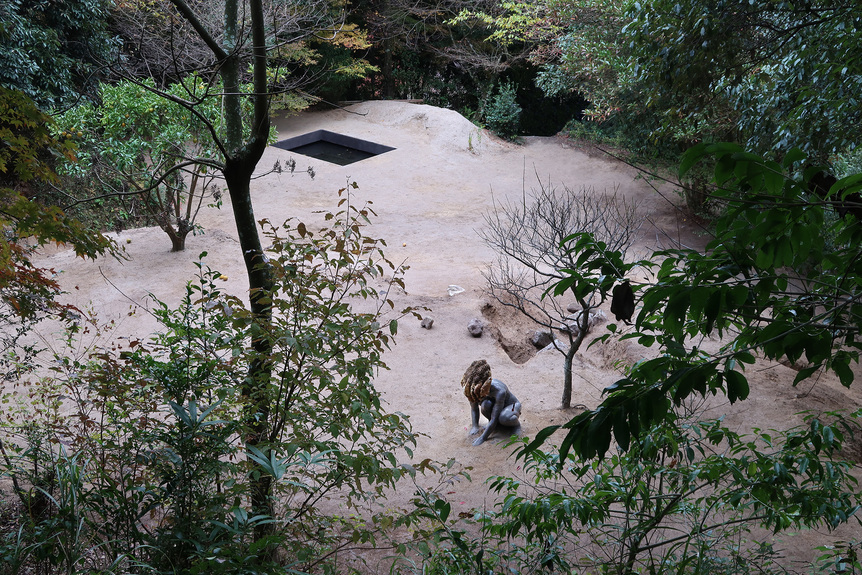
R
E
V N
E
X
T
Other than with the medium of artificial intelligence, it can be difficult for us to imagine art as its own form of life. Paris- and New York-based sculptor and installation artist Pierre Huyghe has attempted to actualize an imaginary world to explore the ontology of objects, challenging anthropocentric conceptions of existence. As the artistic director of Okayama Art Summit 2019, he gathered 17 artists and collectives to create “If the Snake,” an international exhibition and an evolving system, where different forms of life were realized via biological, chemical, and algorithmic processes. In a studio next to the Asahi River, he sat down with ArtAsiaPacific to discuss his approach to the Summit, the potential of fiction-making, and the idea of objects as living entities.
In 2016, you participated in the first edition of the Okayama Art Summit as an artist. How was that different from your experience as the artistic director of the sophomore iteration?
For the first edition, I couldn’t physically come here, so my experience as a participating artist was very distant. For this year’s Summit, I didn’t consider myself a “curator” or think of myself as the “director.” Instead, I tried to imagine what I would like to see as an artist arriving at an exhibition, and what this exhibition could be. I have tried to gather a system of thoughts, rather than this artist or that artwork. I’m more into how people think, how a work is a thought actualized in a certain form, and the different ways in which these thoughts operate. I tried to gather fiction-makers instead of objects.
I was hoping for the capacity of the works to be changeable and responsive in a way that allows their potential to become something else, but without putting forward a theme. When there’s a theme, it is too compact, categorized, and it never fits the artist. No matter what theme it is—the Anthropocene, immigration, or pollution—it never works, because the artist becomes the toy or the tool, a slave for that theme, and I wasn’t ready to do that.
Installation view of PAMELA ROSENKRANZ’s Healer (Waters), 2019, robot, circuit board control units, battery, LED light, 3D printed head and tail and Kirigami skin, dimensions variable, at Okayama Art Summit 2019. Photo by Ola Rindal. Courtesy the artist; Karma International, Long Beach; Miguel Abreu Gallery, New York; and Sprüth Magers, Berlin / London / Los Angeles.
In the curatorial statement published in the Summit’s guidebook, you describe the event, saying: “this infant complex system is prompt to spontaneous order, self-generating, material with consciousness, shifting meaning, constantly modifying its plasticity in total indifference to any potential witness.” Could you explain what you mean by this “infant complex system?”
The process of creating this exhibition involved a lot of back-and-forth: all along the way, the artists shaped the exhibition’s form. I was simply interested in what they wanted to do and helped to make it effective on a practical level. Each artist has their own thoughts—I wouldn’t change their thinking, but I can see the direction that they’re going in and help them with that. Therefore, I consider the exhibition as a living entity, a thing that can change and evolve, like a complex system that is small, young, and not yet defined, with an attempt to create continuity. It is a prototype.
In some way the exhibition as an entity also encompasses the site itself. Can the site become an otherness, a personhood? Can a site be intelligent or conscious? It doesn’t care about others. The site exists by itself. It is fragile, and it might need help. It has a certain degree of consciousness as a different form of life. I know the text [in the exhibition booklet] is far from reality, but it is more like a speculation of what I would have wanted to see. I wrote the text from a position that is very different: that you do not come with a master plan. Behind this system there’s a different agent that produces the game. So that was the approach, and the venues became sites of continuous possibilities for fiction to be raised. The sites surpass what we know.
Speaking of venues, the locations chosen for the Summit included a former elementary school, an old soy sauce factory, the Okayama Castle, and several museums in the area. What was the criteria for this selection?
I tried to keep these places close to each other, so that it is not too spread out and you don’t have to take a 20-minute taxi ride to visit them. The sites were defined by this idea of trying to create continuity.
I felt—as I do with my own projects—that I have to find a kind of naturalness for each work. For example, it is natural to see a painting in a museum, but not hanging on a tree. If you see a digital billboard in the middle of the woods, it’s strange; but if you see it on a building, perhaps it would remind you of Tokyo or Hong Kong. So, for the Summit, the works embedded themselves in their surroundings. Not all of the works do that—and it’s fine if they don’t—but at least I tried to find fitting places for the projects, or to help with the proximity of the work with its environment and the next work. But I didn’t impose that on the artist; I proposed as many possibilities as I could to the participants. By doing so, I helped the work to develop a naturalness or ontology with the place, and within a context such that the work is not compact. In the white cube you destroy the environment, it’s perfectly white, perfect in temperature, with many pedestals. In my approach, I’m completely opposed to that.
For Fabien Giraud and Raphaël Siboni’s The Everted Capital (1971-4936), The Unmanned, Season 2, Episode 2 (2019) and The Form of Not (Infantia) (2019)—a system of tubes—the installation team punched holes in the walls and floors of the former Uchisange Elementary School. Did you encounter any practical challenges transforming the venue, since the school is listed as a heritage site by the Japanese government?
It’s a complicated question that has to do with local politics. It wasn’t easy. For some politicians it’s a problem, but for others, it’s absolutely okay. Giraud and Siboni’s works crossed through the whole building of the elementary school. This network of tubes circulated through the different floors. In the rooms were objects in vacuum plastic bags and a pump sucking oxygen. These elements were bonded by a void. It was necessary to create this entanglement, and highlight the vacuum, because the artists’ fictional world comprises mortals who are keeping immortals as prisoners at this site.
You seem to be very interested in fictions, which you also explore in many of your own artistic projects. Why?
To me, fiction—or the speculative aspect of it—is a vehicle to reach what is thought of as impossible or unreachable. Through fiction, the known and the given can be escaped. In a playful way, fiction is this imagination at work that allows us to shed learned rules.
Eventually, once this other world is reached, you can try to actualize it. As soon as it is realized, it remains perhaps not adaptive to the world but in suspension. To speculate is to play a kind of game, and speculation doesn’t have to be related to the future. It can bypass the idea of time. Speculation can also involve changing the past, or jumping out of this linear thinking. A lot of the artists at this year’s Summit are trying to do that—it is also a concern of mine. We use this speculative aspect of fiction as a way to reach otherness and modify how people think by allowing them to enter this other world. It’s about how we see—not what but how.
You have been visiting Japan in recent years. In 2017, you created EXOMIND (Deep Water), a sculpture of a crouching female whose head is an active beehive, at Fukuoka’s Daizaifu Tenmangu Shrine, for Okayama Art Summit’s pre-exhibition event—another “complex system.” How do you view the culture and religion in Japan?
There was a moment when I became interested in animism, a pillar of Shinto. I was fascinated with the idea of considering everything as living entities, viewing a rock, for example, as a spirit, or a conscious form, on equal footing with a river or a cat. But then I felt that in thinking that the stone or the river should have a spirit, one is imposing one’s own ideas on the material. When I’m talking about a “living entity” or shaping a site as a being, I mean that the site has consciousness not because of you, or us, or humans instilling meanings into the site. Rather, each thing is generative because of biological, algorithmic, and chemical processes. Shinto or animism is a belief system. I would like to create the condition for the object to develop by itself.
You seem to be critical of these belief systems.
I’m always wary of top-down structures. I’m opposed to hierarchy and such orders.
Installation view of MATTHEW BARNEY’s Cathode in Refugium, 2019, engraved copper plate with asphaltum ground In high density polyethylene frame, 45.1 × 51.4 cm, at Okayama Art Summit 2019. Photo by Ola Rindal. Courtesy the artist and Gladstone Gallery, New York / Brussels.
For the Summit, you collaborated with Matthew Barney on an untitled work. Could you tell us about your collaboration?
Yes, it was not my fault. It was Matthew’s fault, in a good way. I invited Matthew to be a part of the Summit with a dynamic work, but he had many other things to do. We were discussing it in his studio in New York, where he had a very interesting series of copper engravings, but I was looking for a work that could be mutable. So instead of presenting a finished work, we decided to show the electroplating process. The copper plate drawing, depicting its future, will be growing in an electroplating tank until the end of the exhibition. After the exhibition it will be hosted in one of my aquariums, which you can see at the Summit, in the same room as Matthew’s tank.
The Okayama Art Summit is on view until November 24, 2019.
Pamela Wong is ArtAsiaPacific’s assistant editor.
To read more of ArtAsiaPacific’s articles, visit our Digital Library.




















